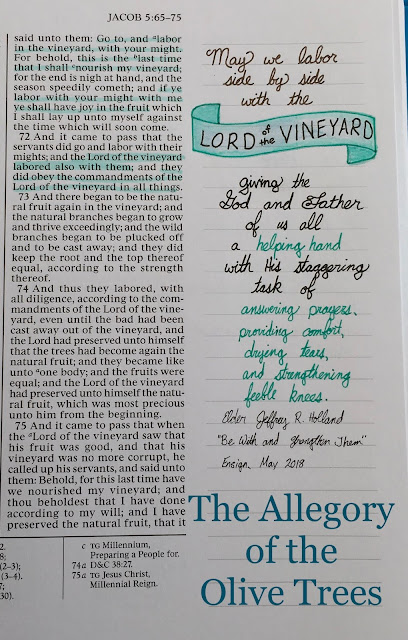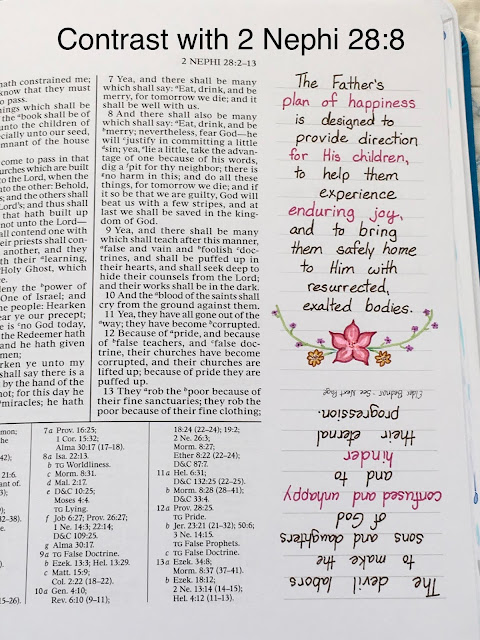Chapter 26 of 2 Nephi begins with a prophesy of when Christ will show himself to the Nephites. This feels very pertinent to us, as we look forward to the Second Coming. I love verse 9, which says, "The Son of Righteousness shall appear unto them; and he shall heal them, and they shall have peace with him." In the sidebar, I traced a coloring page drawing I had made some years ago. I do slightly regret the layers of dark pink Mildliner highlighter to achieve the "red" cape, but I just barely got away without bleeding through to the other side. Underneath, I wrote one of the quotes from that page about Christ. Verses, 8, 9, and 12 have great ones. I chose to use
2 Nephi 26:8:
"Look forward unto Christ."
After the destruction of the Nephites (which must have been upsetting for Nephi to have seen in vision) the prophesies move much farther into the future. When the remainder of Lehi's posterity has dwindled in unbelief and the Gentiles have laid siege against them, then will The Book of Mormon come forth unto them, like "a voice from the dust" (see 2 Nephi 26:14-16). In the margin I wrote:
"
The Book of Mormon speaks by ancient and modern covenant to you who are the children of Lehi, 'children of the prophets.' Your forefathers received a covenant promise that you, their descendants, would recognize a voice as if from the dust in the Book of Mormon," (
Elder Gerrit W. Gong, "Covenant Belonging," Ensign, November 2019).
The chapter ends (2 Nephi 26:33) with an invitation. "He inviteth them all to come unto him and partake of his goodness; and he deniers none that come unto him, black and white, bond and free, male and female . . . all are alike unto God." In the margin I wrote:
"Latter-day Saints come in many shapes and sizes, but 'all are alike unto God' 'black and white, bond and free, male and female,' single and married, rich and poor, young and old, lifelong member and recent convert," (
Sister Michelle Craig of the Young Women Presidency, "Spiritual Capacity," Ensign, November 2019).
The next page I combined two treasure verses into one quote. I began with the end of 2 Nephi 27:21 and then added part of verse 23, because they both spoke to me that day:
"I am able to do mine own work. I am a God of Miracles," (
2 Nephi 27:21 and 23).
There is definitely opposition in all things! In 2 Nephi 28:8, we hear of people preaching to not only "eat, drink, and be merry," but also to commit "little sins." Listening to Satan takes us away from happiness, not toward it! There are two parts to the quote I put in the margin. The oppositional part (about Satan) I chose to write upside down, because that symbolizes his plans to me. I waited until after I had carefully written both parts of the quote before I attempted an embellishment between them.
"The Father's plan of happiness is designed to provide direction for His children, to help them experience enduring joy, and to bring them safely home to Him with resurrected, exalted bodies. The devil labors to make the sons and daughters of God confused and unhappy and to hinder their eternal progression," (
Elder David A. Bednar, "Watchful unto Prayer Continually," Ensign, November 2019).
I always think of 2 Nephi 28:21, when we sing the chorus of "Come, Come Ye Saints" (you know--where we start singing "all is well"). I think Nephi meant something different when he criticized those who said "all is well in Zion," which is why I instead chose a quote about complacency from the above talk by Elder Bednar:
"Spiritual complacency and casualness make us vulnerable to the advances of the adversary," (
Elder David A. Bednar, "Watchful unto Prayer Continually," Ensign, November 2019).
The problem with having called so many places home is that I can feel homesick even after I'm settled into a new place. This illustration is a tribute to South Carolina. The palmetto tree and crescent moon are not just a government symbol. It's a part of community pride. In the margin I wrote the following treasure scripture:
"I remember those who are upon the isles of the sea," (
2 Nephi 29:7).
This next entry is one of my favorites. I had gone back to reread President Nelson's talk from the most recent Women's Session (and some of his recommended reading as well). I found this quote so provoking that I had to find a place to put it. 2 Nephi 30:2 speaks of "covenant people," which ties in with what President Nelson says about endowed women and priesthood covenants, and 2 Nephi 30:5 speaks of a restoration of the gospel of Jesus Christ. Let me know if you found another place in your scriptures for this quote:
"How I yearn for you to understand that the restoration of the priesthood is just as relevant to you as a woman as it is to any man. The heavens are just as open to women who are endowed with God's power flowing from their priesthood covenants as they are to men who bear the priesthood," (
President Russell M. Nelson, "Spiritual Treasures," Ensign, November 2019).
I ended with a simple treasure quote:
"As many as shall believe in Christ shall also become a delightsome people," (
2 Nephi 30:7).
Please share your favorite "treasure verses" or related conference talks in the comments section. I love seeing what other people are up to.
New to my blog? Feel free to browse for more ideas, or check-out my Pinterest board
Book of Mormon Journaling.





















































